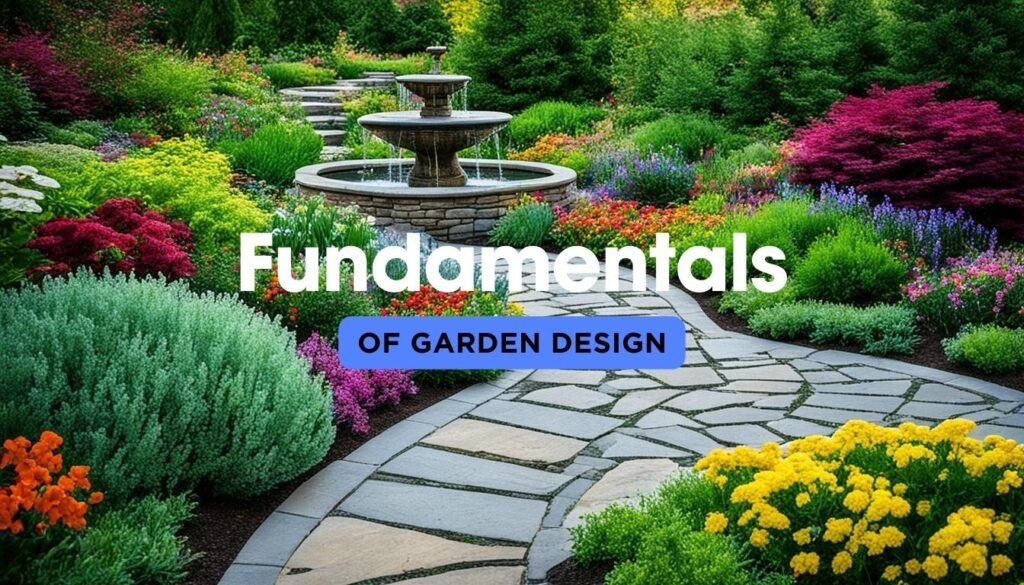Did you know that a well-designed garden can increase the value of a property by up to 20%? That’s right, investing in garden design and landscape architecture can have a significant impact on the overall appeal and value of your outdoor space. Whether you have a small courtyard or a sprawling backyard, understanding the fundamentals of garden design is essential for creating a beautiful and functional oasis. So, let’s explore the key principles of garden design, from outdoor space planning to plant selection, and discover how you can transform your garden into a true masterpiece.
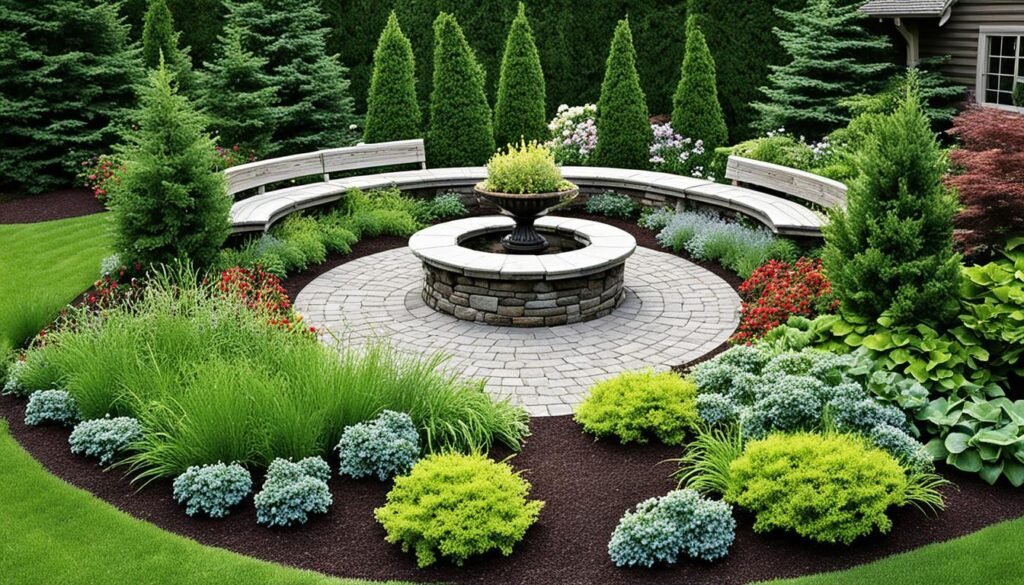
Understanding Space in Garden Design
A key aspect of garden design is understanding space. When planning your outdoor area, it’s essential to consider the layout, dimensions, and how it will be used. Whether you have a large garden or a small balcony, maximizing the available space is crucial to creating a functional and aesthetically pleasing outdoor living environment.
Different zones or outdoor living spaces can be created within your garden to serve various purposes and activities. These spaces can include seating areas for relaxation or entertaining, dining areas for al fresco meals, or even play areas for children. By carefully planning the distribution of these spaces, you can ensure that your garden meets your lifestyle needs.
Additionally, selecting appropriate planting schemes can enhance the sense of depth and visual interest within the space. Consider incorporating different heights, textures, and colors in the plants you choose. Layering plants in a thoughtful way can create depth and make your garden more visually appealing.
When designing your outdoor living spaces, take into account factors such as sunlight exposure, wind patterns, and the natural features of your landscape. Understanding how these elements interact with your garden can help you make informed decisions about the placement of your outdoor living spaces and the selection of suitable plants.
By understanding space in garden design and creating functional outdoor living spaces, you can transform your garden into a beautiful and inviting sanctuary that reflects your personal style and enhances your overall well-being.
Design Principles for Garden Design
When it comes to garden design, understanding and applying design principles can make a significant difference in the overall look and feel of your outdoor space. These principles, such as significant enclosure, regulating lines, and the Golden Ratio, help create a well-designed and visually appealing garden.
Creating Significant Enclosure
Significant enclosure involves creating a sense of refuge and enclosure in your garden. This can be achieved by using elements such as hedges, fences, and trellises to define the boundaries and create a private and intimate atmosphere. Incorporating tall plants and trees can also help create a sense of enclosure and provide shade and privacy.
Using Regulating Lines
Regulating lines help connect and organize the design elements in your garden, creating a cohesive and harmonious layout. These lines act as visual guides and can be achieved through the placement of pathways, borders, and hardscape features. By following regulating lines, you can create a sense of flow and movement throughout your garden.
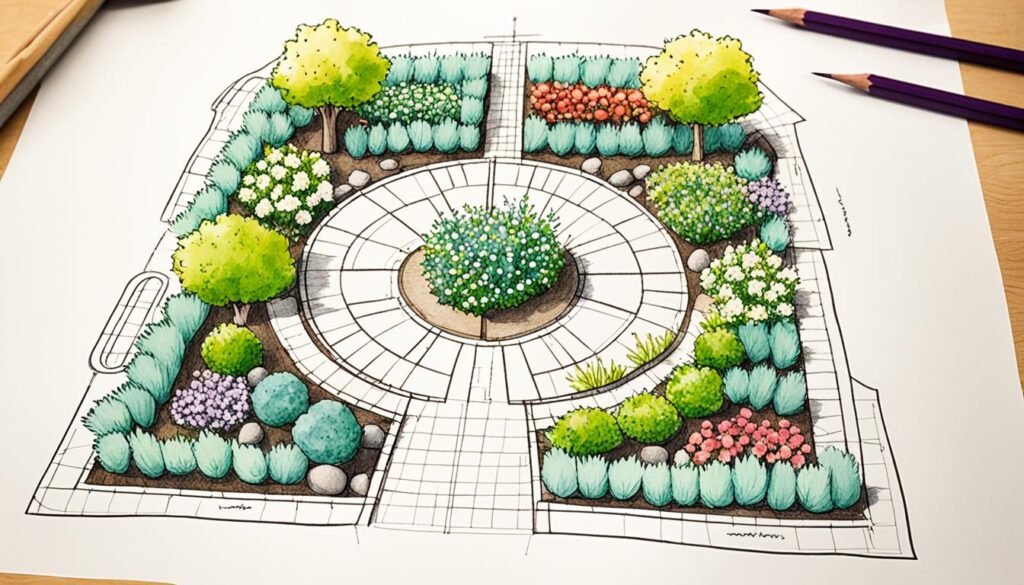
Applying the Golden Ratio
The Golden Ratio is a mathematical ratio of proportion that has been used in design and art for centuries. This ratio can be applied to garden design to achieve a pleasing sense of balance and order. You can incorporate the Golden Ratio by considering the proportions of different garden elements, such as the size and placement of focal points, seating areas, and plant beds.
By understanding and applying these design principles in your garden planning, you can create a space that is not only aesthetically pleasing but also functional and enjoyable. Whether you’re starting from scratch or renovating an existing garden, these principles will help you achieve a well-designed outdoor space that you can truly call your own.
 The ancient Persian ‘Charbagh‘ or four-part garden layout, designed to represent paradise, is a foundational influence in modern garden design, incorporating symmetry, water channels, and a focus on ecological balance.
The ancient Persian ‘Charbagh‘ or four-part garden layout, designed to represent paradise, is a foundational influence in modern garden design, incorporating symmetry, water channels, and a focus on ecological balance.
Choosing a Style for Your Garden
When designing your garden, it’s important to consider the style or theme you want to achieve. There are various garden styles to choose from, such as cottage gardens, formal gardens, or contemporary gardens. Each style has its own aesthetic and features, and choosing the right style can help create a cohesive and harmonious outdoor space.
Cottage gardens are known for their romantic and whimsical appeal, with an abundance of colorful flowers and a relaxed, informal layout. They often feature traditional plant varieties and natural materials, creating a charming and nostalgic atmosphere. This style is perfect for those who appreciate a more traditional and cottage-like garden setting.
On the other hand, formal gardens are characterized by their structured and symmetrical design. These gardens are often meticulously planned and feature geometric shapes, clipped hedges, and neatly arranged beds. Formal gardens exude elegance and order, creating a sophisticated and timeless look. If you prefer a more refined and formal aesthetic, a formal garden style may be the perfect choice for you. For a contemporary garden style, clean lines, minimalist design, and sleek materials are key.
Contemporary gardens often incorporate modern elements such as concrete, steel, and glass, creating a stylish and cutting-edge outdoor space. This style is ideal for those who prefer a sleek and minimalist aesthetic that embraces modern design principles. While choosing a garden style, it’s also important to consider sustainability and urban gardening principles.
Sustainable gardens focus on minimizing water usage, using organic and eco-friendly materials, and creating habitats for local wildlife. By incorporating sustainable practices into your garden design, you can create an eco-friendly and environmentally conscious outdoor space that contributes to the overall well-being of the planet.
Urban gardening, on the other hand, emphasizes the use of limited space in urban areas to grow plants and create green spaces. This can be achieved through vertical gardening, container gardening, or rooftop gardens. Urban gardens bring nature into the city, providing a sense of tranquility and connection with the natural world.
By exploring urban gardening techniques, you can transform even the smallest spaces into thriving and vibrant green oases. In conclusion, choosing a garden style is an essential step in the garden design process. Consider your personal preferences, the features of each style, and the principles of sustainability and urban gardening. By selecting the right style, you can create a beautiful and unique outdoor space that reflects your individuality and provides a sanctuary in which to relax and enjoy nature’s beauty.
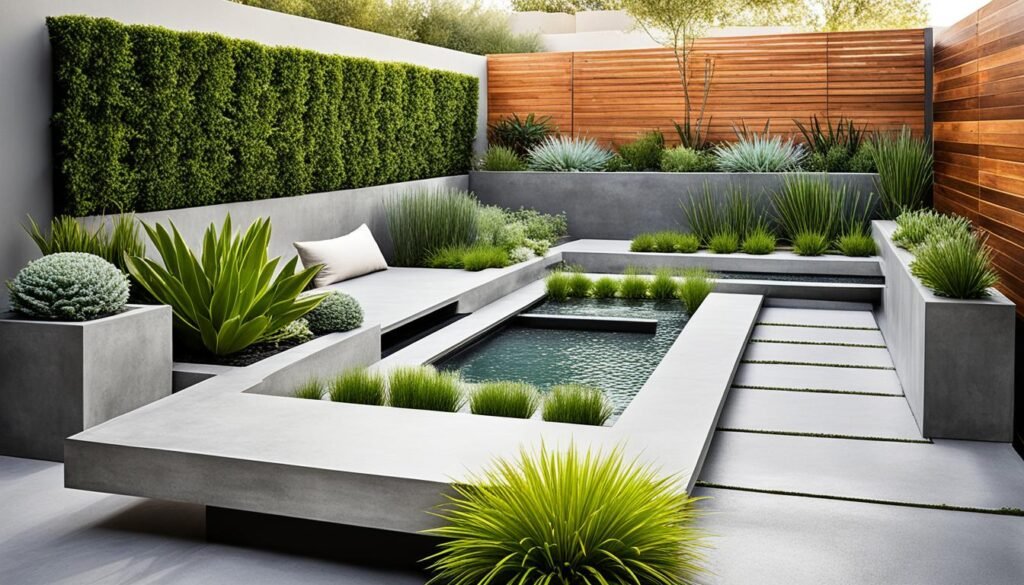
Planning Your Layout
Now that you have a clear understanding of your garden’s space and style, it’s time to plan the layout. This crucial step involves determining the placement of different elements to create a well-designed and functional outdoor space.
To begin, consider the flow and functionality of the space. Think about how you and your guests will move through the garden and how different areas can be connected. This will help you decide where to place paths, patios, and seating areas.
When planning your layout, it’s important to strike a balance between practicality and visual appeal. Your garden should not only be a functional space but also a visually pleasing one. Take into account the proportions and scale of your outdoor area, and how different elements can complement each other.
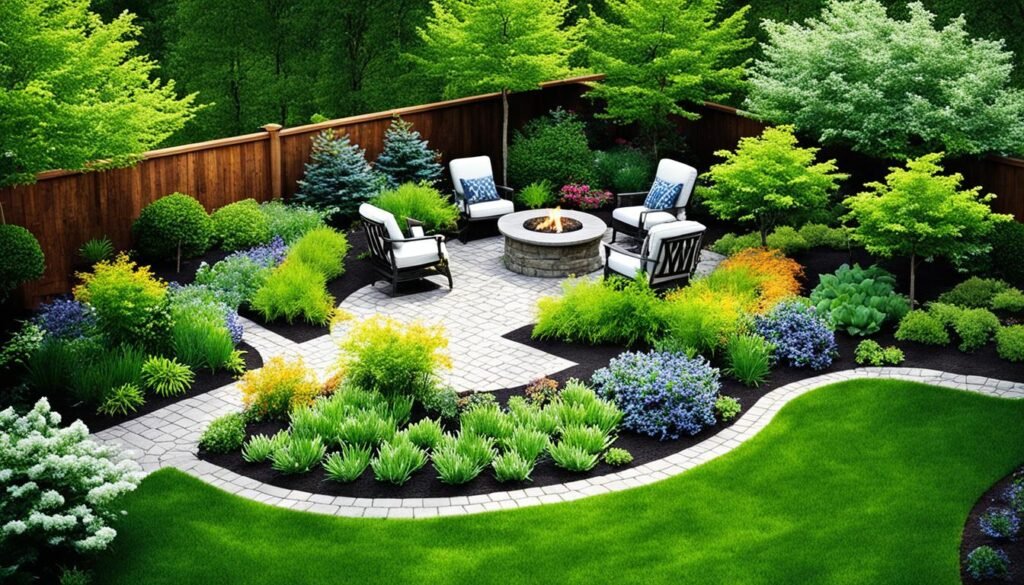
Paths are an essential part of garden design, as they guide visitors through the space and create a sense of movement. Consider using materials that are in harmony with the overall style of your garden, whether it’s stone, gravel, or even wood.
Patios and seating areas are ideal for outdoor entertaining or simply enjoying a cup of tea in your garden. Determine the size and location of these areas based on your needs and the available space.
Plant beds are another important element of the garden layout. They provide opportunities for incorporating colors, textures, and scents into your outdoor space. Carefully select the types of plants that will thrive in your garden’s conditions and complement the overall design.
By planning your layout thoughtfully, you can create a garden that is not only practical but also visually stunning. Remember to take into account the flow, functionality, and visual appeal of the space as you make decisions about the placement of paths, seating areas, and plant beds.
Selecting Plants for Your Garden
When it comes to garden design, selecting the right plants is essential for creating a stunning and harmonious outdoor space. The choice of plants can greatly impact the overall aesthetic and atmosphere of your garden. Consideration should be given to factors such as the climate, soil conditions, and the desired aesthetic. By carefully selecting plants that will thrive in your specific garden environment, you can ensure their long-term success and contribution to the overall design.
One key consideration when choosing plants is their height. By selecting a variety of plants with different heights, you can create visual interest and layers within your garden. Tall plants can provide structure and act as focal points, while shorter plants can be used to fill gaps and add texture to the overall planting scheme.
Color is another important element to consider when selecting plants. Choose a color palette that complements your garden’s overall design and evokes the desired mood. Vibrant and bold colors can create a lively and energetic atmosphere, while soft and muted tones can create a sense of tranquility. Additionally, consider how the colors of the plants will interact with each other and the surrounding environment.
Texture is also an important aspect to consider when selecting plants. Varying the textures of plants can add depth and visual interest to your garden. Plants with fine, delicate foliage can create a soft and airy feel, while plants with bold and coarse textures can add drama and contrast.
When designing your planting scheme, it’s important to create a well-balanced composition. This can be achieved by considering the size, shape, and growth habit of each plant. A mix of different types of plants, such as trees, shrubs, perennials, and annuals, can create a dynamic and ever-changing garden throughout the seasons.
Remember, plants are living organisms that require care and maintenance. Ensure that you are familiar with the specific care requirements of each plant you choose and that they are suitable for your garden’s environment. Regular watering, pruning, and fertilizing will help keep your plants healthy and thriving.
Tips:
- Select plants that thrive in your garden’s specific climate and soil conditions.
- Consider the height, color, and texture of plants to create a visually appealing planting scheme.
- Create a well-balanced composition by considering the size, shape, and growth habit of each plant.
- Regular care and maintenance are crucial for the health and longevity of your plants.
Incorporating Hard Landscaping Features
When designing a garden, incorporating hard landscaping features is essential to create structure and visual interest. Hard landscaping elements such as pathways, walls, fences, and water features serve to define different areas within the garden and create focal points.
Pathways not only provide functional access to various parts of the garden but also add a sense of charm and elegance. They can be made using a variety of materials, including natural stone, gravel, or bricks, depending on the desired style and theme of the garden. Consider curving pathways to create a sense of flow and lead the eye through the space.
Walls and fences can add privacy, security, and structure to the garden. They can be used to separate different areas and create a sense of enclosure. Opt for materials that complement the overall design, such as brick, stone, or timber. Climbing plants can be trained to grow on walls or fences, adding a touch of greenery and softening the hard surfaces.
Water features, such as fountains or ponds, not only create a calming atmosphere but also serve as focal points in the garden. The soothing sound of running water can create a sense of tranquility. When incorporating a water feature, ensure that it is in harmony with the overall design and consider factors like maintenance and water conservation.
Choosing Materials for Hard Landscaping Features
When selecting materials for hard landscaping features, it’s important to consider the style, theme, and functionality of your garden. Opt for materials that will withstand weather conditions and the test of time. For example, natural stone can add a classic and timeless look to a garden but may require more maintenance than other materials. Alternatively, concrete pavers offer durability and a wide range of design options.
Additionally, consider sustainable and eco-friendly materials for hard landscaping features. Using reclaimed or recycled materials can add a unique and environmentally conscious touch to your garden design. Incorporating permeable surfaces, such as gravel or porous paving, can also help manage water drainage and reduce runoff.
By carefully selecting and incorporating hard landscaping features, you can enhance the overall design and functionality of your garden. Whether it’s creating inviting pathways, adding privacy with walls and fences, or introducing the soothing sound of a water feature, these elements contribute to a beautifully crafted outdoor space.

Adding Garden Accessories
When it comes to garden design, the little details can make a big difference. Garden accessories are the perfect finishing touches that can elevate your outdoor space to the next level. Whether it’s a stunning sculpture, stylish containers, or comfortable furniture, these accessories can enhance the overall aesthetic and create a sense of personality and style in your garden.
But how do you choose the right garden accessories that will complement your design? Consider elements such as size, material, and color. The size of the accessories should be in proportion to the space they will occupy, avoiding anything too overpowering or too small. The material should be durable and weather-resistant, ensuring that your accessories can withstand the British climate and stand the test of time. And don’t forget about color – selecting accessories that harmonize with the existing color palette of your garden can create a cohesive and visually pleasing look.
One popular garden accessory is a sculpture. A well-placed sculpture can become a focal point and add a touch of elegance or whimsy to your garden. Whether it’s a classical statue or a modern abstract piece, choose a sculpture that speaks to your personal taste and complements the overall design of your outdoor space.
Another essential garden accessory is containers. These versatile pieces can be used to showcase vibrant flowers, lush green foliage, or even aromatic herbs. Select containers in different sizes and shapes to add visual interest and create depth in your garden. Experiment with materials such as terracotta, ceramic, or metal to suit your style and the overall mood of your outdoor space.
Finally, don’t forget about garden furniture. Comfortable seating areas allow you to relax, dine, and entertain outdoors. From wooden benches to rattan loungers, choose furniture that suits your needs and complements the design of your garden. Don’t forget to add cushions and throws to create a cozy and inviting atmosphere.
By carefully selecting and incorporating garden accessories, you can add the perfect finishing touches to your outdoor space. These accessories not only enhance the overall aesthetic but also reflect your personal style and create a garden that feels like an extension of your home. So, go ahead and let your creativity flourish as you explore the world of garden accessories!
 Ancient Egyptian gardeners were tool pioneers, using sophisticated copper shovels and hoes as early as 3000 BC. These tools were not just functional but also a symbol of the advanced agricultural techniques that supported their lush, ornamental gardens.
Ancient Egyptian gardeners were tool pioneers, using sophisticated copper shovels and hoes as early as 3000 BC. These tools were not just functional but also a symbol of the advanced agricultural techniques that supported their lush, ornamental gardens.
Maintaining Your Garden
Once your garden is designed and planted, it’s important to maintain it to keep it looking its best. Proper garden maintenance is key to ensuring the longevity and health of your plants, as well as the overall beauty of your outdoor space.
One essential aspect of garden maintenance is regular watering. Your plants rely on consistent hydration to thrive and flourish. Be sure to water them thoroughly, taking into account the specific needs of each plant. A good rule of thumb is to water deeply and less frequently, allowing the soil to dry out slightly between waterings.
Pruning is another crucial maintenance task for your garden. By removing dead or overgrown branches and foliage, you not only enhance the appearance of your plants but also promote healthy growth and flowering. Trim back any damaged or diseased areas to prevent further spread and maintain the overall shape and structure of your plants.
Fertilizing your garden is essential to provide the necessary nutrients for plant development. Choose a suitable fertilizer based on the specific needs of your plants and apply it according to the instructions. Regular fertilization will help ensure strong, vibrant, and resilient plants.
To keep your garden looking tidy and weed-free, it’s important to regularly remove weeds. Weeds compete with your plants for resources and can hinder their growth. Take the time to pull weeds by hand or use appropriate weed control methods to maintain a clean and healthy garden environment.
Lastly, be vigilant in managing pests that may threaten the health of your garden. Keep an eye out for common garden pests such as aphids, snails, and slugs. Use appropriate pest control methods, such as natural predators or organic pesticides, to protect your plants from infestations.
By incorporating these garden maintenance practices into your routine, you can ensure the beauty and vitality of your garden throughout the seasons. Regular watering, pruning, fertilizing, weed control, and pest management will help you create an outdoor space that brings joy and tranquility to your life.
Conclusion
Garden design is a fascinating and intricate process that combines knowledge of space, design principles, plant selection, and overall maintenance. By following these fundamental steps, you can create a garden that not only enhances the aesthetic appeal of your outdoor space but also brings tranquility and joy to your life.
Through careful planning and consideration, you can transform your garden into a beautiful and functional oasis. Selecting appropriate plants and materials, incorporating hard landscaping features, and adding the perfect garden accessories will help create a cohesive and harmonious design.
However, the journey doesn’t end with the initial design. Garden renovation and maintenance are essential to keeping your outdoor space fresh and vibrant. Regular watering, pruning, and assessing the overall condition of your garden will ensure its longevity and health.
So, whether you’re starting a new garden or renovating an existing one, remember to embrace the fundamentals of garden design, keeping in mind the importance of garden renovation and maintenance. With dedication and love for your garden, you can create a space that truly reflects your style and brings you joy for years to come.

